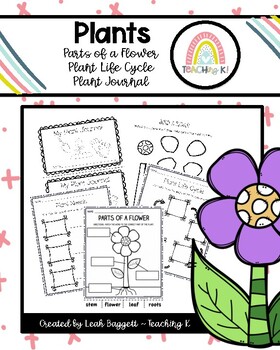Plants: Parts of a Plant, Plant Needs, Life Cycle, & Plant Journal for Primary
Teaching K
481 Followers
Resource Type
Standards
CCSSW.K.2
NGSSK-ESS2-2
NGSSK-LS1-1
Formats Included
- PDF
- Easel Activity
Pages
19 pages
Teaching K
481 Followers
Easel Activity Included
This resource includes a ready-to-use interactive activity students can complete on any device. Easel by TPT is free to use! Learn more.
What educators are saying
This was a great add-on to our unit about plants. My students used the resources to create their own posters showing the parts of a plant and explaining how a plant grows.
Fun, and easy activity for them to use independently to understand the parts of a flower. My students loved working on this activity.
Description
Plants: Parts of a Plant, Plant Needs, and Life Cycle Activities for Primary for Kindergarten and 1st Grade
Includes:
Cover
Contents
Parts of a Flower Labeling Activity
Build a Flower Art Activity #1
Build a Flower Art Activity #2
Draw the Plant Life Cycle Activity
Plant Needs Draw & Label Activity
My Plant Journal (10 Days- Observe, Draw, & Write)
Terms of Use
Credits
Use during Science, Science Centers, Writing Center, Morning Work, Etc.
Please follow my store for monthly freebies! :)
Total Pages
19 pages
Answer Key
N/A
Teaching Duration
N/A
Report this resource to TPT
Reported resources will be reviewed by our team. Report this resource to let us know if this resource violates TPT’s content guidelines.
Standards
to see state-specific standards (only available in the US).
CCSSW.K.2
Use a combination of drawing, dictating, and writing to compose informative/explanatory texts in which they name what they are writing about and supply some information about the topic.
NGSSK-ESS2-2
Construct an argument supported by evidence for how plants and animals (including humans) can change the environment to meet their needs. Examples of plants and animals changing their environment could include a squirrel digs in the ground to hide its food and tree roots can break concrete.
NGSSK-LS1-1
Use observations to describe patterns of what plants and animals (including humans) need to survive. Examples of patterns could include that animals need to take in food but plants do not; the different kinds of food needed by different types of animals; the requirement of plants to have light; and, that all living things need water.






